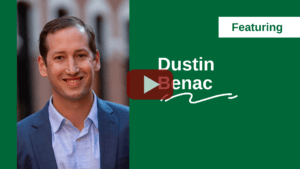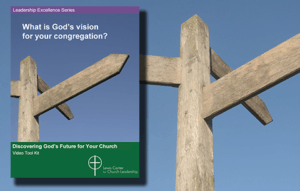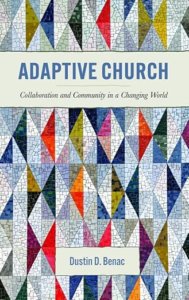
How can the church adapt to future challenges and foster community through innovative leadership? In this episode Doug Powe and Dustin Benac discuss the future of the church, emphasizing collaborative leadership, the importance of belonging, and adapting to cultural shifts through innovative community structures.
Listen on Apple Podcasts | YouTube Music | Spotify
Watch on YouTube

- Transcript — Click or Tap to Read
-
Announcer: Leading Ideas Talks is brought to you by the Lewis Center for Church Leadership of Wesley Theological Seminary in Washington, DC. Subscribe free to our weekly e-newsletter, Leading Ideas, at churchleadership.com/leadingideas.
Leading Ideas Talks is also brought to you by Discovering God’s Future for Your Church. This turnkey video tool kit helps your congregation discern and implement God’s vision for your church’s next faithful steps. Learn more and watch an introductory video at churchleadership.com/vision.
How can the church adapt to future challenges and foster community through innovative leadership? In this episode Doug Powe and Dustin Benac discuss the future of the church, emphasizing collaborative leadership, the importance of belonging, and adapting to cultural shifts through innovative community structures.
Doug Powe: Welcome to Leading Ideas Talks, a podcast featuring thought leaders and innovative practitioners. I am Douglas Powe, the Director of the Lewis Center and your host for this talk. Joining me is Dr. Dustin Benac, the Director and Co-founder of the Program for the Future of the Church at George W. Truitt Theological Seminary at Baylor. He’s the author of Adaptive Church. Our focus for this podcast is the future church. Dustin, thank you for joining us. I’m looking forward to this conversation.
Dustin Benac: Thrilled to be here, Doug. Thanks for the hospitality and the good work you lead at the Lewis Center.
Doug Powe: I’m going to word this maybe a little bit differently than you would, but I know one of your passions is helping congregations discern “what’s next.” How did this become a passion for you?
Dustin Benac: Yeah, great question. I would say it emerged, first, out of a commitment to care. So, all of the work that I do is animated by a commitment to care for individuals and communities, particularly amid times of transition and uncertainty. And one of the things I realized by listening to so many faith communities across the country is that times of transition and uncertainty can be bewildering. They leave us feeling unsure, they leave us feeling uncertain, and they leave us feeling like the future is unclear. And out of that commitment to care, I realized that there was an incredible opportunity to come alongside individuals and communities as they were discerning “what’s next” that was enlivened by the work of the Christian tradition, hopefully infused by the wisdom of the spirit of God, and then could be informed by insights from broader landscape of research and practice. So, it really was the combination of these things where I realized there was an opportunity to serve in a meaningful way; and an opportunity to offer something back when so many communities, so many leaders were disoriented and were really losing hope.
The second thing I’d say is I have just had so many people do that for me. That’s the gift of life together, is when you feel stuck, when you feel bewildered, when you feel uncertain, when you feel like you don’t know if you have it in you to take the next step, somebody has come alongside me and said, “Dustin, I believe in you. I believe in your work. I believe in your organization. There’s good, holy healing work ahead of you. Even when you don’t know what the next step is.” So, it’s the combination of those things that drew me in.
Doug Powe: I want to start digging into the book, and I’m going to ask you to do something that’s very unfair. I’m going to ask you to give a 2-minute overview of the book to sort of orient our listeners.
Dustin Benac: Happily, happily. First, I’d say innovation always takes place and adaptation always takes place. So, the contextual center for the book is the Pacific Northwest because the Pacific Northwest is a context that has a history of religious innovation and also a marginal position for religious organizations. Innovation is in the water, and yet innovation happens on the edges; and many faith leaders and scholars of religion think that the Pacific Northwest is an indicator where religion is going in North America. So, I spent several years in the Pacific Northwest working with two organizations that were collaborative, locally rooted, and contextually centered—The Office of Church Engagement and the Parish Collective—in order to discern both what’s going on and what’s possible together. The first half of the book describes what’s happening in the region, the histories of these organizations, and their collaborative structures. I identify them as a novel and emerging organizational form that I call a “hub,” which anchors religious life within a particular community and facilitates these webs of connection across a broader ecology.
And then the second half of the book engages in a broader theological re-description about not just what’s going on, but what’s possible. It reads the story of these organizations in line with the story of Luke-Acts. It reads them through the lens of Dietrich Bonhoeffer’s work, it uses some of Craig Dykstra’s work around pastoral and ecclesial imagination, and then finally, it concludes by describing a new model for collaborative leadership that allows us to move beyond leading alone and offers several—not prescriptive—but imagined possibilities of what’s possible on the other side of Christendom.
Doug Powe: I want to dig into this a little bit more. And you know in the time we have, I can’t do complete justice to the work you’ve done, but I want to try to unpack for our listeners some of the pieces you just outlined, and I want to start with the “Hub.” You use this language, and you use it in a technical way. A hub for you is sort of a way a faith community can be formed but thinking about a faith community as more than just a congregation. And so, can you sort of describe what you mean by a hub and why you think this language may be more helpful than just simply saying a “congregation?”
Dustin Benac: Yeah, certainly. I would say for three reasons. One, this is language that’s all around us in the public square. If you just look around at ads, if you watch the Olympics, if you read the newspaper, you will see that this “hub” and “hub-like” language is everywhere. So first, I think it has popular purchase, and this is a way of describing the goods of religious and congregational life in a way that might make a little bit more popular sense. That’s the first thing, it’s a way of describing what’s already going on.
The second thing I would say, is it describes faith communities at their best. Faith communities and religiously related organizations have always had this “hub-like” character. They have always rooted religious life in a particular locale and community. They’re placed, they’re local, they’re geographically indexed, they take up real estate, for better or worse. And yet, they also facilitate these webs of connections across a broader landscape. This is the story of my life. I imagine it’s the story of your life, Doug, where we are connected in and through communities of faith. So, that’s the second reason.
The third reason is we know that American religious life is shifting in profound ways. Ted Smith’s brilliant book, The End of Theological Education describes, I think, as well as anybody, this profound shift from voluntary associations to autonomous individualized orders. It doesn’t mean individuals aren’t connecting, but they’re connecting in different ways. And one of the things I think we see in the Pacific Northwest, as well as others, is people are connecting to these “hub-like” realities, where it’s this porous, a little bit more fluid, but still rooted in relational reality that provides a structure of belonging but also facilitates webs of connection well outside of the building.
Doug Powe: So just as a follow up, if I’m hearing you correctly, one of the challenges then of “congregation”—I’m going to use that language of “congregations”—is we actually look more similar to volunteer associations, and we look less like what you are arguing for and describing now as a “Hub.” And that, if we can move towards the reality of looking more like a hub, we actually would better fit in terms of making those connections that you’re talking about. So, I say all of that to ask: Do you think this is something that we’re reclaiming in Christianity, or is this new and innovative of moving towards this idea of a “Hub?”
Dustin Benac: I would say it’s always going to be a both-and. This is the conjunctive imagination. Like I mentioned early on, this “hub-like” reality has always marked the Christian tradition. You see this in the story of Luke-Acts. That’s one of the reasons I talk about in my book networks and early Christianity—how they function, how they form, how they’re carried by stories and letters and particular practices. So, faith communities have always had this “Hub-like” character. The forms of faithful witness that have marked moments of innovation and renewal in the life of the faith have always had this “hub-like” character. There’s a density of social connection, and also a diversity of connection across communities of faith. And at the same time, I think we are in a moment where this hub-like character needs to be reimagined and re-expressed. This is where, for me, the language of imagination is really critical, because it’s an invitation to see in a new way. And that seeing that we’re invited to do involves looking backwards to see the wisdom that comes from our tradition, looking local to see the wisdom that is embedded in our communities, and also looking forward in a hopeful way about how we together can imagine and renew our faith communities in and through the spirit of God for the people of God.
Doug Powe: So having said all of that, there are challenges, and you outline these challenges to creating this hub-like existence. Can you sort of outline those challenges? And this leads us to, then, why adaptive change is needed.
Dustin Benac: Yeah, I would say there are a number of challenges that people identify, both in the Pacific Northwest and also in the broader work that I’ve done since then. I started doing this work for Adaptive Church, goodness, probably five or six years ago, and you know, asked for a catalog of challenges. And people identified things like loneliness; they talked about identifying and engaging key constituents; they talked about financial resources; they talked about buildings; they talked about isolation. These were the realities that they named in their context, in their communities. They talked about what I called “managing transitions and boundary zone work,” moving from one way of being to another. And the striking thing, Doug, is when I talked to leaders, both before the pandemic and after the pandemic, the same leaders in these communities of faith, I asked them: “Have these challenges changed?” And almost without an exception, they said “No, the challenges have not fundamentally changed.” They’ve only, they’ve only thickened. They’ve only become more complex. And those communities of faith that were already practiced in the art of innovation and were already locally connected were able to weather the disruptions of the pandemic more easily than those that were disconnected. So, I think that’s the first striking thing. The pandemic didn’t fundamentally alter the structure of challenges. It just exacerbated challenges that were already there.
The other opportunity that I think the pandemic, and the series of crises that have followed, it finally convinced people that collaboration is the way forward. It demonstrated for people there is a less meaningful future for faith without others. And so, it broke that open and gave us a willingness and an appetite to partner, and maybe even to partner across meaningful differences and divisions. I think that’s the second meaningful thing.
And then, since doing that work, as I’ve tried to experiment and institutionalize, and contextualize this work through the program For the Future of Church at Baylor’s Truett Seminary, I’ve found what I think are a constellation of three or four related challenges that I think are unique and pressing in this moment. First is the crisis of belonging. I think belonging is the question of our generation, particularly the generation in the wake of these cascading crises. We all want to know where we belong. And particularly for faith leaders who are serving in a polarized context, they feel like they don’t belong because they are in the middle and polarized on both sides.
Second, the crisis of loneliness and leadership. So many individuals, and so many religious leaders, find themselves lonely—and lonely like never before. As one of my students said, “it is lonely at the top.” The vocation of religious leadership is characteristically lonely and is lonely in unique ways. That’s the second unique challenge.
Third, I think there’s this challenge of mental health and burnout. That’s been well documented. We don’t need to rehearse that here, but what I think is unique is that this crisis of mental health and burnout is interrelated to these previous crises around belonging, leadership, and loneliness. You find yourself thin, and frail, and mentally worn out and burnt out when you don’t feel like you belong, and when you’re lonely in your leadership.
And then, 4th and finally, I think there is a challenge and crisis around “calling”—particularly, calling for the next generation. If fewer and fewer people of the following next generation are finding meaningful identity and faith communities, and calling oftentimes comes in the company of others, we need to consider: How do we equip? How do we call? And how do we help people discern that God has a call upon their life?
Discovering God’s Future for Your Church is a turnkey tool kit to help your congregation discern and implement God’s vision for its future. The resource guides your church in discovering clues to your vision in your history and culture, your current congregational strengths and weaknesses, and the needs of your surrounding community. Learn more and watch an introductory video now.
Doug Powe: Let me interject here. And I could pick up on all of those and we could talk the rest of the afternoon but let me think about “belonging” for a second. You talked about it from the perspective of the leader, and I want you to say, maybe, a little bit more about being trapped in the middle, because I think that’s interesting given, of course, what is happening in our country now politically and the challenge that presents. So how can a leader create belonging in that situation?
The second aspect of that I’m thinking about is belonging from the perspective of those coming to a faith community. So, given the fact of all of the challenges you’ve talked about, it seems like we should do a better job of creating space for others to belong. What do you think are the challenges of why we have not been able to do that as well, given that leaders themselves face this challenge?
Dustin Benac: Yeah, I think it’s, you know, a reality, Doug. And the first thing I’ll say is for those, those who are listening, I simply want to name the reality of the precarity that you face—particularly if you’re a leader who has been serving thoughtfully and faithfully and feel like you don’t have a people, or you feel like if people have left, or if you’re a person of faith who has been looking for a space to belong, and you just feel like congregations aren’t those space. I just want to validate those experiences because it’s a reality. And the way I oftentimes think about this and talk about this in a way that kind of humanizes belonging, is belonging is the air we breathe. We all need belonging. We need it to survive. We don’t just need it as a strategy. It’s not a growth strategy. It’s not a retention strategy. It’s not a development strategy. It’s a fundamental shared human need that we all need. And that means we need it as religious leaders. We need it as congregants. And the terrifying thing is that those who we disagree with need it as well. Those who we might think of or feel and experience as our enemies, they need belonging as well.
So that’s the first thing I’d say.
At a more practical level, I think leaders can create cultures of belonging by doing a few things. One, telling the truth. I think we have oftentimes proffered a myth that our faith communities offer more belonging than they actually do. So, I think we need to tell the truth about where we are. Secondly, I think we need to tell the truth about our own longing for belonging. When I have this conversation with faith leaders, they oftentimes lean in and just almost feel like they have to whisper because when you say out loud that, “I’m not sure if I belong and I don’t know where I have my people,” you say something that, that might be true about yourself and true about your world, that then means that you have to act in a new way. So, tell the truth. Third, I would say, find your people and hold onto your people. Wherever your people are, hold on to them. They might be your family. They might be your colleagues. They might be your classmates. They might be people in your city, in your congregation. They also might not be there. I’m convinced that each of us has a people; we long for a people, and we can also create and build spaces of belonging. And that’s the fourth thing, is I’d say take the first step. We all long to belong, and one of the things I think faith leaders can do is they can build those structures in their congregations and also beyond their congregations.
As for people in our communities, particularly in our faith communities, I think there are several practical things we can do. One, we can lean in and cultivate cultures of trust. That means we need to have accountability structures. That means we need to have transparent financial practices. That means we need to support our leaders and have thoughtful, theologically educated, ethical leaders. So, build cultures of trust—promote trust. I, secondly, I would say, show up amid the busyness that carries each of us in all of our lives. It’s easier not to show up than it is to show up oftentimes, but you will never feel like you will find belonging if you don’t show up. Third, take the risk. Belonging is always a risk. It involves offering something of yourself and receiving the gift of belonging for others. So, take that risk, show up, invite people into your home, take the risk of inviting somebody to a conversation. And then fourth and finally, I would say participate in associational life. Belonging happens together. You don’t do it on your own. You can’t find it alone. You find it in, in the context of community, connection, conversation, and you need to participate in associational life to find belonging.
Doug Powe: Having set all this up, we get to the part I really appreciate: imagination. And I want you to really think practically for those who are in faith communities. They hear those of us, particularly in academy, talking about innovation, imagination. We use this language, and we don’t mean to, but we make it sound easy. But the reality is this is the hard work. So, what can you say practically to our listeners to help them really think about, “How do I really cultivate imagination, so that we can move toward this idea of a hub?”
Dustin Benac: I would say several things. First, listen to what’s going on right where you are. And this is really the, the gift of wisdom I learned from the communities I study in the Pacific Northwest. These are faith communities and leaders who have spent decades listening to the wisdom of their local communities. You probably don’t first need a consultant. You don’t need another big book. You have wisdom right where you are. So, listen to what’s going on in your community. Listen to your neighbors. Listen to the sages and guides in your congregation and in your neighborhood because they, they will tell you what you need. And they will also tell you what you don’t need, because there might be things you think are well intended that actually aren’t meeting the need in your local community. So, that would be the first thing I’d say – is listen, and listen attentively, and take time.
The second thing I would say is move at the speed of trust. Innovation, particularly innovation that’s collaborative, can only move as fast as you have trust. That takes time, and I know time feels like a precious commodity, particularly if faith communities feel constrained; they feel like they have shrinking resources; they feel like time is ticking. But I would simply invite faith communities to use time as the governor and determiner of the pace that you move—not some predetermined outcome, grant metric, or arbitrary deliverable. Move at the speed of trust.
Third, read widely within the scriptures, within theology, and well beyond scriptures in the theological tradition. Some of the most creative and imaginative people I know are folks who know the scriptures, they know the breadth of the Christian tradition, and they also read so much more. They read poetry, they read novels, they read fiction, they read biographies. And even some of the metaphors that came for Adaptive Church, as I was talking about collaborative leadership, they came from Dante’s Inferno. They’re not coming from Luke-Acts or Calvin or Bonhoeffer or Jennings, they’re coming from poetry and these epic dramas. So, I’d say that: read widely.
And then 4th, I would suggest that people work to not do it alone. You’ve got to learn how to lead and work in a way that’s collaborative, that’s connectional. And this is the wisdom of the Wesleyan tradition. You don’t lead alone. There’s a connectional system, and you allow the wisdom of a collective to enrich and inform your work. And then fifth and finally, I’d say take the first step. Innovation isn’t something that moves forward with a clear and fixed and predetermined strategy. It’s something where faith communities are just taking the next faithful step. And then the next one. And then the next one, and the next one. It’s that iterative, faithful, contextual, imaginative work that’s carried by hope, but it’ll only start moving if you take the first step.
Doug Powe: As we get ready to bring this to an end, Dustin, let me end with this. What is the future of the church?
Dustin Benac: What is the future of the church? I love that question, Doug. As we think about the future of the church, and when people ask me to look at my crystal ball and consider what is the future of the church, I simply admit that there is much that we don’t know. But we do know that the Spirit of God has sustained the church and will continue to sustain the church into the future. And the one thing I’m willing to bet on, and have made a bet on in meaningful ways, is that the future of the church will be more collaborative and contextual than it’s ever been. So, as we’re thinking about the pathways forward for the future of the church, I think some of the best spaces to imagine and invest are in collaboration and in context. Because it’s through our connections to others that we will discern what the future is, and it is through the places that God has called us and invited us where we will learn what is our work to do.
Doug Powe: Thank you. This has been a great conversation. And I look forward to many more, even though they may not be for public consumption.
Dustin Benac: Likewise, Doug. Delighted to have the conversation. Thanks for the invite.
Announcer: Thank you for joining us for Leading Ideas Talks.
Don’t forget to subscribe to our free weekly e-newsletter, Leading Ideas, to be notified when new episodes are published. Visit churchleadership.com/leadingideas.
Adaptive Church: Collaboration and Community in a Changing World by Dustin Benac (Baylor University Press, 2022). The book is available at the publisher and Amazon.
Related Resources
- Sustaining While Disrupting by Doug Powe and Lovett Weems
- A New Model for Leading Change by Doug Powe and Lovett Weems
- 6 Leadership Practices that Enhance Involvement and Collaboration by Katie Carson Phillips
- Building Vibrant Community Connection in Digital and Physical Spaces featuring Jordana Wright — Watch the Leading Ideas Talks podcast video | Listen to the podcast audio version | Read the in-depth interview
If you would like to share this article in your newsletter or other publication, please review our reprint guidelines.
Featured image by magann on Lightstock






